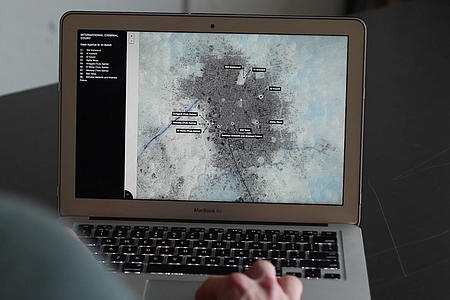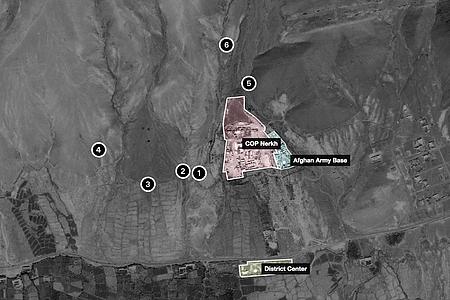ICC Digital Platform and the Al Hassan Case
The first ever interactive platform for experiencing courtroom evidence at the ICC shows its utility in the Al Hassan case
Client
International Criminal Court, Office of the Prosecutor
Location
Timbuktu, Mali
Completion
2024
After working closely with the Office of the Prosecutor at the International Criminal Court (ICC) on the Al Mahdi case in 2016, SITU Research was reengaged by the ICC in the spring of 2018 to begin work on a new case focused on defendant Al Hassan Ag Abdoul Aziz.
Mr. Al Hassan was an alleged member of Ansar Eddine and de facto chief of Islamic police during Timbuktu’s occupation by Jihadist groups in 2012 and 2013. He was transferred to the ICC on March 31, 2018, following an arrest warrant that found him to be responsible for war crimes and crimes against humanity. These violations included intentionally directing attacks against buildings dedicated to religion and historic monuments, rape and sexual slavery. Notably, this case is the first ICC prosecution of the crime of persecution on the grounds of gender.
On June 26th, 2024, following the conclusion of his trial, Mr. Al Hassan was found guilty by a panel of three judges for other related crimes, a complete list of which can be found here. He was acquitted of charges of directing attacks against buildings dedicated to cultural and religious sites and on all gender-based violence charges. Mr. Al Hassan’s sentencing will be announced soon.
The platform
To improve the process of presenting evidence, and based on the success of the previous work on the Al Mahdi platform, the ICC engaged SITU to create an interactive platform that can be queried in many ways and be used dynamically throughout all aspects of the trial. Featuring a virtual reconstruction of the city of Timbuktu, the platform provides the ability to locate, place, and display evidentiary assets in two and three-dimensions as they relate to the built environment. This allows the user to navigate the city at a range of scales—from the broad urban context to the details of interior spaces and even individual objects.
Because the alleged crimes were committed across various locations across Timbuktu, the virtual model was designed to allow the Prosecution, Defense, and Judges to navigate the city and gain a comprehensive understanding of these events in both time and space.
In the previous case for the ICC, SITU designed a platform that allowed the viewer to access evidence by clicking on icons laid out over a satellite image. For this case, we built a tool that visually contextualizes historical footage within a digital model of the city. A significantly more ambitious undertaking than the Al Mahdi platform, the Mr. Al Hassan platform required the integration and interoperability of a much broader range of assets—from 3D data, video assets, photos and satellite imagery to panoramic images and geospatial data.
In addition to the computational work, we also performed an intensive evaluation of the ICC’s audio-visual infrastructure to ensure the platform functioned seamlessly during proceedings. The platform was, indeed, used throughout proceedings. An additional technical consideration was that all of the data feeding the platform needed to be stored offline. This constraint, essential to maintaining the chain of custody, required significant development in preparation for handing over the platform for use at trial.
The trial
During the Confirmation of Charges hearing and throughout the trial itself, the prosecution loaded the platform and displayed it on all the courtroom screens for the judges, witnesses and audience members. The platform was used by the prosecution to walk the judges through the crimes Mr. Al Hassan had been charged with. For every charge, the lawyer navigated the platform to the site of the crime and, when available, displayed footage of Mr. Al Hassan committing the alleged crime. Evidence included videos showing the accused instructing militants wearing Islamic Police uniforms or carrying out sentences. The camera shifted into the viewpoint of the photograph or video such that the footage integrated within the digital model was seamless.
The objective of the digital model for the platform is twofold: it is both to support contextualization (to help strengthen witness testimony) and corroboration (to show that evidence was taken in the purported locations). Specifically, the digital model allowed the judges and other parties unable to travel to Timbuktu to contextualize the alleged crimes. The approach is particularly helpful in this case as the security situation in Mali remains poor, precluding any possibility of the judges visiting the sites in person. Navigating the interactive platform’s different sites and scales also became essential during witness testimony as questions from the judges necessitated needing to move through various parts of the city. For example, if a judge wanted a better grasp of the layout of a central square where floggings were carried out, they were able to zoom into that location and explore it. A prosecutor may also want to demonstrate how the accused forced a witness to walk from their house to the square to watch these punishments; the platform allows the stakeholders to do this.
The second objective was to corroborate the prosecution’s argument that the evidentiary assets—videos and photos showing Mr. Al Hassan allegedly acting as the chief of Islamic police—were indeed taken in the purported locations. In addition to more traditional forms of 2D geolocation, the digital model allows the legal team to corroborate placement in 3D. An example in this trial is when the prosecution placed historical video footage in a high resolution 3D model of the headquarters of the Islamic Police housed in a former bank building. All parties in the courtroom could then directly observe how well the footage matched the high fidelity 3D modeling.
The reconstruction
In order to reconstruct a digital model of the city of Timbuktu and specific sites in higher detail, we processed and synthesized laser scans that the ICC forensic team captured on site. In parts of the city where laser scans were not available due to security concerns and lack of time, the only documentary footage available was ground photographs and videos, as well as drone footage. Those areas of the city are presented at much lower resolution but often have sufficient detail to be effective for contextualizing and corroborating the location of historical footage.
Accountability
The platform has been used as the primary vehicle to present video and photographic evidence in the Al Hassan case—a clear indication of how the ICC has increased its use of digital and visual media in its investigations over the past few years.
In a recent essay titled "Innovation and Technology in Building Modern Investigations and Prosecutions at the ICC," Chief Prosecutor Karim Khan reflects on the use of the digital platform in the Al Hassan case:
The potential advantages of this way of presenting such evidence are manifold and may include: avoiding the necessity of certain potentially dangerous site visits for the judges; presenting evidence to the judges in a user-friendly and accessible manner; and enabling witnesses in the courtroom to discuss relevant evidence in a more comprehensive way. Trial Chamber X’s acceptance of the platform shows that the law and procedure of the ICC is ready to accommodate forward-thinking approaches to the presentation of evidence.
Notably, counsel representing Mr. Al Hassan did not challenge the use of the platform themselves, provided that all evidence presented therein would be admitted into evidence separately.Indeed, the defense sought full access to the virtual platform, and required (and were provided) training and guidance on its use, so that they could also deploy it as needed. As noted by Trial Chamber X, the parties reached mutual agreement with regard to the defense’s access to the platform.
More information about the verdict on the ICC’s website can be found here.






